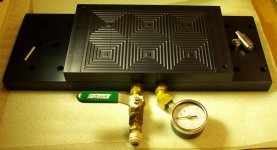#5 ii Alive!
Aluminum
- Joined
- May 12, 2018
Hello, Hello.
I've begun exploring building a small DIY vacuum table. I don't need a footprint much larger than 24" x 24"
Excuse my ignorance, but is there a way to create a vacuum-holding system without needing a huge compressor (which I do not have) or a large vacuum pump (which I also don't have) -- in other words, without spending a bucketload of money? My work-piece is made from plastic, measures less than two inches across, and weighs less than and ounce, so I don't need a huge amount of suction. You guys are always full of great ideas and know-how.
Thanks in advance for sharing your expertise.
#5
I've begun exploring building a small DIY vacuum table. I don't need a footprint much larger than 24" x 24"
Excuse my ignorance, but is there a way to create a vacuum-holding system without needing a huge compressor (which I do not have) or a large vacuum pump (which I also don't have) -- in other words, without spending a bucketload of money? My work-piece is made from plastic, measures less than two inches across, and weighs less than and ounce, so I don't need a huge amount of suction. You guys are always full of great ideas and know-how.
Thanks in advance for sharing your expertise.
#5



